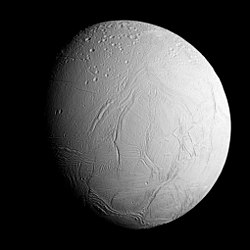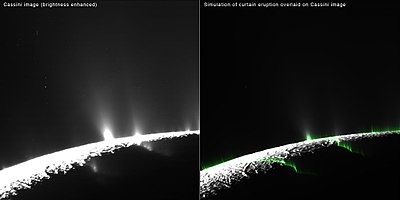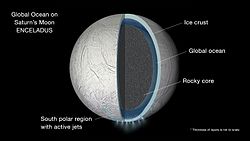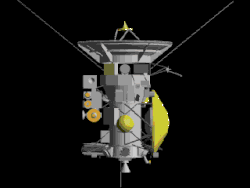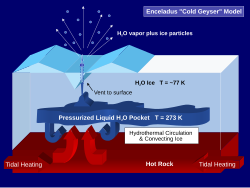PIA17198-Enceladus-20151026hd
http://photojournal.jpl.nasa.gov/catalog/PIA17198
UPLOADER NOTE (Drbogdan (diskuse) 14:57, 27 October 2015 (UTC)):
Converted original .MOV file to .WEBM file - via "MIRO Video Converter"
This animated sequence of images, captured by NASA's Cassini spacecraft, shows changes in the brightness of the Enceladus plume during a 6.5-hour observation.
The change in plume brightness during this observation is due almost entirely to the changing sun-Enceladus-spacecraft angle, or phase angle. Over the course of the observation, the phase angle changed from 149 to 155 degrees.
Tiny water ice particles make up the bulk of the plume as imaged by Cassini's cameras. These particles tend to scatter light toward the viewer much more at higher phase angles than lower ones. Imaging scientists process such images to remove variations in brightness due to the changing phase angle in order to study the plume's true variation in brightness. Observing how the brightness of the plume varies throughout the icy moon's orbit can help scientists understand the nature of the mechanisms that force material to Enceladus' surface.
The variability in brightness of the background is due partly to Cassini observing Enceladus through Saturn's E-ring and partly due to the changing phase angle. The frames with a brighter background were taken when the line of sight through the E ring was greater than in the frames with a darker background.
These views look toward the leading hemisphere of Enceladus. North on the icy moon is up. The images were taken in visible light with the Cassini spacecraft narrow-angle camera on May 10, 2015. The views were acquired at distance of approximately 220,000 miles (350,000 kilometers) from Enceladus. Image scale is about 1 mile (2 kilometers) per pixel.
The Cassini mission is a cooperative project of NASA, ESA (the European Space Agency) and the Italian Space Agency. The Jet Propulsion Laboratory, a division of the California Institute of Technology in Pasadena, manages the mission for NASA's Science Mission Directorate, Washington. The Cassini orbiter and its two onboard cameras were designed, developed and assembled at JPL. The imaging operations center is based at the Space Science Institute in Boulder, Colorado.
For more information about the Cassini-Huygens mission visit http://saturn.jpl.nasa.gov and http://www.nasa.gov/cassini. The Cassini imaging team homepage is at http://ciclops.org.Relevantní obrázky
Relevantní články
Enceladus (měsíc)Enceladus je šestý největší měsíc planety Saturn. Měsíc má v průměru téměř 500 kilometrů, což je přibližně desetina velikosti největšího měsíce Saturnu, Titanu. Enceladus je z většiny pokryt mladým a relativně čistým ledem, který odráží téměř veškeré sluneční světlo dopadající na jeho povrch. To má za následek extrémně nízkou teplotu povrchu pohybující se okolo -198 °C. I přes svou malou velikost se na Enceladu nachází celá řada povrchových útvarů od starších oblastí silně posetými impaktními krátery po novější útvary vzniklé v posledních 100 milionech let. Rozsáhlou geologickou aktivitu vyvolávají patrně slapové síly planety Saturn, podobně jako u Jupiterových měsíců Io a Europa, protože vlastní významné zdroje tepla z radioaktivního rozpadu mít Enceladus s ohledem na svou velikost nemůže. Předpokládá se, že k zahřívání přispívá i rezonanční vazba Enceladu s měsícem Dione v poměru 1 : 2, což vyvolává uvnitř obou měsíců dodatečné slapové síly, a spolupůsobit může i měsíc Mimas. Vliv slapových sil by však nestačil k roztavení ledu, proto se vědci domnívají, že nitro Encelada musí obsahovat i jiné těkavé látky s nízkým bodem varu. Na ledovém povrchu lze rozpoznat nejméně pět různých typů terénů: četné deformace, trhliny a prolákliny, ale jen málo impaktních kráterů, z nichž jsou mnohé přetvořené plastickým tečením povrchových vrstev měsíce. Největší kráter má průměr asi 35 km. Z jejich absence je tak zřejmé, že povrch je relativně mladý. .. pokračovat ve čtení



